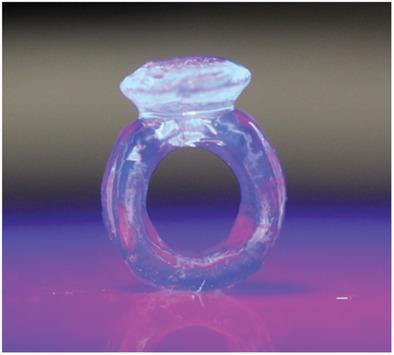当前位置:
X-MOL 学术
›
Adv. Mater.
›
论文详情
Our official English website, www.x-mol.net, welcomes your
feedback! (Note: you will need to create a separate account there.)
Highly Tunable Thiol‐Ene Photoresins for Volumetric Additive Manufacturing
Advanced Materials ( IF 27.4 ) Pub Date : 2020-10-01 , DOI: 10.1002/adma.202003376 Caitlyn C. Cook 1 , Erika J. Fong 1 , Johanna J. Schwartz 1 , Dominique H. Porcincula 1 , Allison C. Kaczmarek 1 , James S. Oakdale 1 , Bryan D. Moran 1 , Kyle M. Champley 1 , Charles M. Rackson 2 , Archish Muralidharan 3 , Robert R. McLeod 2 , Maxim Shusteff 1
Advanced Materials ( IF 27.4 ) Pub Date : 2020-10-01 , DOI: 10.1002/adma.202003376 Caitlyn C. Cook 1 , Erika J. Fong 1 , Johanna J. Schwartz 1 , Dominique H. Porcincula 1 , Allison C. Kaczmarek 1 , James S. Oakdale 1 , Bryan D. Moran 1 , Kyle M. Champley 1 , Charles M. Rackson 2 , Archish Muralidharan 3 , Robert R. McLeod 2 , Maxim Shusteff 1
Affiliation

|
Volumetric additive manufacturing (VAM) forms complete 3D objects in a single photocuring operation without layering defects, enabling 3D printed polymer parts with mechanical properties similar to their bulk material counterparts. This study presents the first report of VAM‐printed thiol‐ene resins. With well‐ordered molecular networks, thiol‐ene chemistry accesses polymer materials with a wide range of mechanical properties, moving VAM beyond the limitations of commonly used acrylate formulations. Since free‐radical thiol‐ene polymerization is not inhibited by oxygen, the nonlinear threshold response required in VAM is introduced by incorporating 2,2,6,6‐tetramethyl‐1‐piperidinyloxy (TEMPO) as a radical scavenger. Tuning of the reaction kinetics is accomplished by balancing inhibitor and initiator content. Coupling this with quantitative measurements of the absorbed volumetric optical dose allows control of polymer conversion and gelation during printing. Importantly, this work thereby establishes the first comprehensive framework for spatial–temporal control over volumetric energy distribution, demonstrating structures 3D printed in thiol‐ene resin by means of tomographic volumetric VAM. Mechanical characterization of this thiol‐ene system, with varied ratios of isocyanurate and triethylene glycol monomers, reveals highly tunable mechanical response far more versatile than identical acrylate‐based resins. This broadens the range of materials and properties available for VAM, taking another step toward high‐performance printed polymers.
中文翻译:

用于批量增材制造的高度可调硫酚烯光敏树脂
体积增材制造(VAM)可以在一次光固化操作中形成完整的3D对象,而不会分层缺陷,从而使3D打印的聚合物零件的机械性能类似于散装材料的对应零件。这项研究提出了VAM印刷的硫醇烯树脂的第一份报告。借助井然有序的分子网络,硫醇化学可以访问具有广泛机械性能的聚合物材料,从而使VAM超越了常用丙烯酸酯配方的限制。由于自由基硫醇烯的聚合不受氧的抑制,因此通过引入2,2,6,6-四甲基-1-哌啶基氧基(TEMPO)作为自由基清除剂,引入了VAM中所需的非线性阈值响应。通过平衡抑制剂和引发剂的含量来完成反应动力学的调节。将其与吸收的体积光学剂量的定量测量值相结合,可以控制印刷过程中聚合物的转化和凝胶化。重要的是,这项工作由此建立了第一个全面的时空控制体积能量分布的综合框架,展示了通过体层摄影体积VAM在硫醇树脂中打印的3D结构。具有不同比例的异氰脲酸酯和三甘醇单体的硫醇烯系统的机械表征显示出高度可调的机械响应,远比相同的丙烯酸酯基树脂更具通用性。这拓宽了VAM可用的材料和性能范围,朝着高性能印刷聚合物迈出了又一步。重要的是,这项工作由此建立了第一个全面的时空控制体积能量分布的综合框架,展示了通过体层摄影体积VAM在硫醇树脂中打印的3D结构。具有不同比例的异氰脲酸酯和三甘醇单体的硫醇烯系统的机械表征显示出高度可调的机械响应,远比相同的丙烯酸酯基树脂更具通用性。这拓宽了VAM可用的材料和性能范围,朝着高性能印刷聚合物迈出了又一步。重要的是,这项工作由此建立了第一个全面的时空控制体积能量分布的综合框架,展示了通过体层摄影体积VAM在硫醇树脂中打印的3D结构。具有不同比例的异氰脲酸酯和三甘醇单体的硫醇烯系统的机械表征显示出高度可调的机械响应,远比相同的丙烯酸酯基树脂更具通用性。这拓宽了VAM可用的材料和性能范围,朝着高性能印刷聚合物迈出了又一步。具有不同比例的异氰脲酸酯和三甘醇单体的硫醇烯系统的机械表征显示出高度可调的机械响应,远比相同的丙烯酸酯基树脂更具通用性。这拓宽了VAM可用的材料和性能范围,朝着高性能印刷聚合物迈出了又一步。具有不同比例的异氰脲酸酯和三甘醇单体的硫醇烯系统的机械表征显示出高度可调的机械响应,远比相同的丙烯酸酯基树脂更具通用性。这拓宽了VAM可用的材料和性能范围,朝着高性能印刷聚合物迈出了又一步。
更新日期:2020-11-25
中文翻译:

用于批量增材制造的高度可调硫酚烯光敏树脂
体积增材制造(VAM)可以在一次光固化操作中形成完整的3D对象,而不会分层缺陷,从而使3D打印的聚合物零件的机械性能类似于散装材料的对应零件。这项研究提出了VAM印刷的硫醇烯树脂的第一份报告。借助井然有序的分子网络,硫醇化学可以访问具有广泛机械性能的聚合物材料,从而使VAM超越了常用丙烯酸酯配方的限制。由于自由基硫醇烯的聚合不受氧的抑制,因此通过引入2,2,6,6-四甲基-1-哌啶基氧基(TEMPO)作为自由基清除剂,引入了VAM中所需的非线性阈值响应。通过平衡抑制剂和引发剂的含量来完成反应动力学的调节。将其与吸收的体积光学剂量的定量测量值相结合,可以控制印刷过程中聚合物的转化和凝胶化。重要的是,这项工作由此建立了第一个全面的时空控制体积能量分布的综合框架,展示了通过体层摄影体积VAM在硫醇树脂中打印的3D结构。具有不同比例的异氰脲酸酯和三甘醇单体的硫醇烯系统的机械表征显示出高度可调的机械响应,远比相同的丙烯酸酯基树脂更具通用性。这拓宽了VAM可用的材料和性能范围,朝着高性能印刷聚合物迈出了又一步。重要的是,这项工作由此建立了第一个全面的时空控制体积能量分布的综合框架,展示了通过体层摄影体积VAM在硫醇树脂中打印的3D结构。具有不同比例的异氰脲酸酯和三甘醇单体的硫醇烯系统的机械表征显示出高度可调的机械响应,远比相同的丙烯酸酯基树脂更具通用性。这拓宽了VAM可用的材料和性能范围,朝着高性能印刷聚合物迈出了又一步。重要的是,这项工作由此建立了第一个全面的时空控制体积能量分布的综合框架,展示了通过体层摄影体积VAM在硫醇树脂中打印的3D结构。具有不同比例的异氰脲酸酯和三甘醇单体的硫醇烯系统的机械表征显示出高度可调的机械响应,远比相同的丙烯酸酯基树脂更具通用性。这拓宽了VAM可用的材料和性能范围,朝着高性能印刷聚合物迈出了又一步。具有不同比例的异氰脲酸酯和三甘醇单体的硫醇烯系统的机械表征显示出高度可调的机械响应,远比相同的丙烯酸酯基树脂更具通用性。这拓宽了VAM可用的材料和性能范围,朝着高性能印刷聚合物迈出了又一步。具有不同比例的异氰脲酸酯和三甘醇单体的硫醇烯系统的机械表征显示出高度可调的机械响应,远比相同的丙烯酸酯基树脂更具通用性。这拓宽了VAM可用的材料和性能范围,朝着高性能印刷聚合物迈出了又一步。











































 京公网安备 11010802027423号
京公网安备 11010802027423号